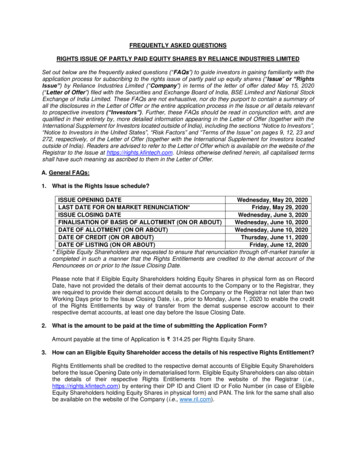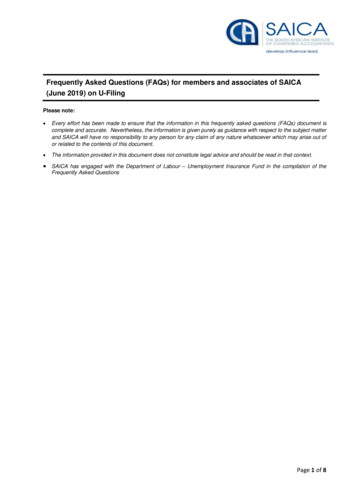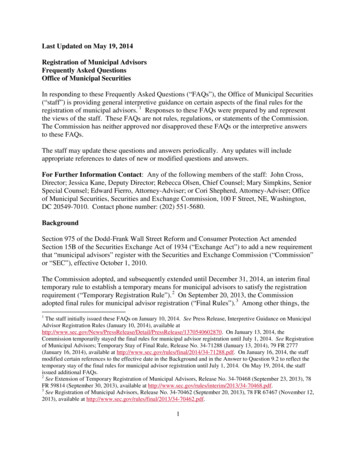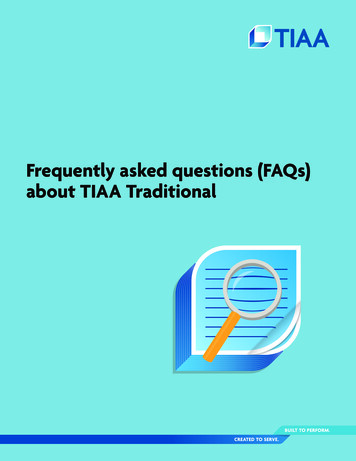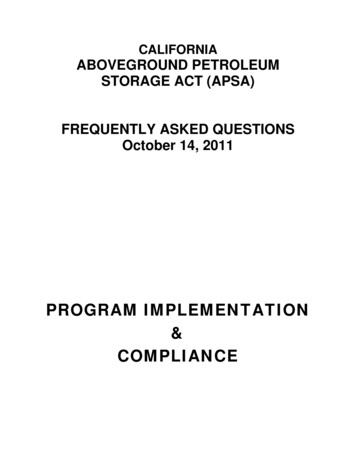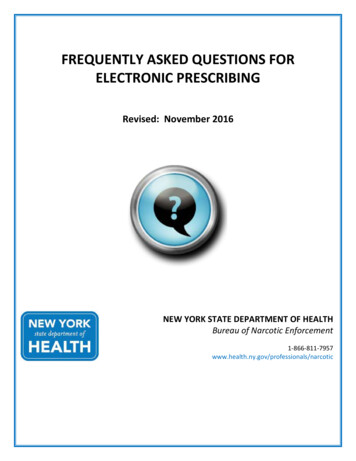
Transcription
FREQUENTLY ASKED QUESTIONS FORELECTRONIC PRESCRIBINGRevised: November 2016NEW YORK STATE DEPARTMENT OF HEALTHBureau of Narcotic ionals/narcotic
Electronic PrescribingFrequently Asked QuestionsContentsLaws and Regulations for Electronic Prescribing of Controlled Substances (EPCS) . Page 1Physician Assistant and Pharmacy EPCS Registration Form . . Page 11Registration for Official Prescriptions and E-prescribing Systems (ROPES) Page 15Software and Data Requirements .Page 21Waivers and Exceptions .Page 22Online Electronic Prescribing Waiver Requests (EPW) .Page 24Practitioner Reporting Requirement Page 59Certifications .Page 60Resource Information and Contacts .Page 62Laws and Regulations for Electronic Prescribing of ControlledSubstances (EPCS)Q1: What is Electronic Prescribing of Controlled Substances or EPCS?A1: Amendments to Title 10 NYCRR Part 80 Rules and Regulations on Controlled Substances have beenadopted and became effective as final regulations on March 27, 2013. The amendments authorize apractitioner to issue an electronic prescription for controlled substances in Schedules II through V andallow a pharmacist to accept, annotate, dispense and electronically archive such prescriptions. Adefinition of an electronic prescription can be found in Section 3302 Article 33 Public Health Law. Clickon the following link for Section 3302; Section 3302 Article 33 Public Health Law.Q2: Is Electronic Prescribing mandatory for New York State practitioners?A2: As of March 27, 2016 it will be mandatory for practitioners, excluding veterinarians, to issueelectronic prescriptions for controlled and non-controlled substances. Electronic prescribing ofcontrolled substances will require additional security features and registration of the certified softwareapplication with the Bureau of Narcotic Enforcement.Q3: Why will electronic prescribing of controlled and non-controlled substances be mandatory effectiveMarch 27, 2016?A3: New York Education Law Article 137 §6810 requires that all prescriptions be transmitted electronicallythree years from the Department of Health’s promulgating regulations allowing for the electronicprescribing of controlled substances. These regulations became effective on March 27, 2013.Utilizing modern prescription technology has the potential to minimize medication errors for patients inNew York State. Electronic prescribing also allows for the integration of prescription records directly intothe patient’s electronic medical record. Electronic prescribing has the potential to reduce prescriptiontheft and forgery.New York State Department of HealthPage 1Bureau of Narcotic Enforcement
Electronic PrescribingFrequently Asked QuestionsQ4: Will the use of Official New York State Prescription forms be prohibited as of March 27, 2016?A4: Official New York State Prescription forms may be used in the event of a power outage or technicalfailure, or by practitioners who meet one of the exceptions listed in Article 2A - Section 281 or Title 10Part 80 Section 80.64. Please review this section of the law and regulations, which may be accessed fromthe following links: Article 2A - Section 281 and Title 10 Part 80 Section 80.64Q5: Should I return all of my unused Official New York State Prescription forms to BNE?A5: Not necessarily. Under limited circumstances, the use of an Official NYS Prescription form will stillbe allowed, including events of a power outage or technological failure. However, it is unlikely thatpractitioners and institutions will need to continue to keep a similar inventory as in the past. Pleaseconsider the amount of prescription paper you will need to keep on hand, safeguard any stored OfficialNew York State Prescription forms and return unneeded or unwanted forms to the Bureau of NarcoticEnforcement at 150 Broadway, Albany, NY 12204. The Bureau of Narcotic Enforcement will continue tosupply Official New York State Prescription forms to practitioners and institutions.Q6: I currently electronically prescribe non-controlled substances. Are there any additional steps I needto complete in order to electronically prescribe controlled substances?A6: Yes. First, the software you currently use must meet all the federal security requirements for EPCS,which can be found on the Drug Enforcement Agency’s (DEA) web page.http://www.deadiversion.usdoj.gov/ecomm/e rx/Note that federal security requirements include a third party audit or DEA certification of thesoftware.Second, you must complete the identity proofing process as defined in the federalrequirements.Third, you must obtain a two-factor authentication as defined in the federal requirements.Fourth, you must register your DEA certified EPCS software with the Bureau of NarcoticEnforcement (BNE). Registration instructions are included in the FAQs.Q7: Can I electronically prescribe controlled substances before it becomes mandated on March 27,2016?A7: EPCS became permissible in NYS on March 27, 2013. Practitioners can electronically prescribecontrolled substances if: The EPCS software application meets all of the federal security requirements for EPCS, whichcan be found on the DEA’s web page. http://www.deadiversion.usdoj.gov/ecomm/e rx/Note that federal security requirements include a third party audit or DEA certification of thesoftware. The practitioner has completed identity proofing as defined in the federal requirements and The practitioner has obtained a two-factor authentication as defined in the federalrequirements and The practitioner has registered their DEA certified EPCS software application with the Bureauof Narcotic Enforcement (BNE). Please refer to the Registration instructions included belowin the section titled “Registration for Official Prescriptions and E-prescribing Systems” or“Physician Assistant and Pharmacy EPCS Registration Form”, whichever is applicable.New York State Department of HealthPage 2Bureau of Narcotic Enforcement
Electronic PrescribingFrequently Asked QuestionsQ8: If only 5 days or less of a controlled substance is prescribed, does the prescription need to betransmitted electronically?A8:Yes. Any amount of controlled substances being prescribed requires the prescription to betransmitted electronically. An exception to this is that a paper or oral prescription may be issued for acontrolled substance, that does not exceed a 5 day supply, ONLY if the practitioner reasonably determinesthat it would be impractical for the patient to obtain substances prescribed by electronic prescription ina timely manner, AND such delay would adversely impact the patient’s medical condition.Q9: Can a prescriber fax a prescription to a pharmacy after March 27, 2016?A9 Yes, under very limited circumstances defined in Public Health Law (PHL) Section 281(3) and TheCommisioner of Health's Letter, provided that the following criteria are met:a. Must be a fax of an original hard copy prescription;b. Must be manually signed by the prescriber; andc. If issued in NY, must be on an Official New York State Prescription form.In most instances, faxed prescriptions for controlled substances must comply with requirements for oralprescriptions for controlled substances, including issuance of the follow-up prescription.A facsimile is not an electronic prescription and must bear a manual signature.Q10: Will it be permissible for a NY practitioner to fax a prescription for a 30 day supply of a controlledsubstance for a patient in a Hospice Program or a RHCF to a NY pharmacy once e-prescribing becomesmandatory?A10: No, unless the prescription is issued pursuant to one of the exceptions in the regulation, 10NYCRRSec. 80.64. Faxed prescriptions are not considered electronic prescriptions.Q11: Is an electronic facsimile of a prescription considered an electronic prescription?A11: No. A definition of an electronic prescription can be found in Section 3302 Article 33 Public HealthLaw and specifically states that a prescription generated on an electronic system that is printed out ortransmitted via facsimile is not considered an electronic prescription. Click on the following link forSection 3302: Section 3302 Article 33 Public Health Law.Q12: Is it permissible for an intermediary to convert an electronic prescription for a controlled substanceto an electronic fax in the event of a transmission failure?A12: At no time may an intermediary convert an electronic prescription for a controlled substance tofacsimile for transmission to the pharmacy if the electronic transmission fails.Q13: Is it permissible for an intermediary to convert a non-controlled substance electronicPrescription to an electronic fax in the event of a transmission failure of the electronic prescription?A13: At no time may an intermediary convert an electronic prescription to a facsimile prescription fortransmission to the pharmacy if the electronic transmission fails. Education Law, Section 6802 specificallyNew York State Department of HealthPage 3Bureau of Narcotic Enforcement
Electronic PrescribingFrequently Asked Questionsexcludes facsimiles from the definition of an electronic prescription. In order to be an acceptableprescription a facsimile must be issued on the Official New York State Prescription and contain a manualsignature. In the event of a transmission failure, an intermediary may send a facsimile notification to thepharmacy. This notification will be for informational purposes only and is not considered a validprescription.Q14: I work for the Department of Veterans Affairs on federal property. Do I need to register mycertified EPCS software application with BNE?A14: No, practitioners who practice on federal property do not fall under the jurisdiction of New YorkState. However, a practitioner working on federal property who also practices off of federal propertywithin New York State, the EPCS software application that is used off of federal property must beregistered with BNE.Q15: Can a practitioner who prescribes controlled substances electronically from multiple practicesites change the practice site address on the prescribing software or choose from multiple practicessite addresses within the software to transmit the correct practice site address to the pharmacy?A15: Practitioners should speak to their software vendor regarding the functionality around practicesite addresses.Q16: Will practitioners be required to issue electronic prescriptions for compounds containing acontrolled substance ingredient as of March 27, 2016?A16: BNE is aware that there may be system limitations due to the NCPDP script standard. Please monitorBNE’s webpage for more information.Q17a: Will practitioners be required to electronically prescribe non-prescription items, includingdurable medical equipment?A17a: No, an electronic prescription will not be required. Section 281 (1) of the Public Health Lawspecifically references the use of electronic prescriptions for prescription drugs only.Q17b: If a third party payor requires a prescription for payment of non-prescription items, includingdurable medical equipment, can it be electronically prescribed?A17b: Consult with your electronic prescribing software vendor to ascertain if the e-prescribing softwareis capable of transmitting these items correctly. If not, a written ONYSRx, manually signed, ispermissible. A “failover” electronic fax is never permissible. The only acceptable facsimile is a manuallysigned ONYSRx.Q18: Can an agent or employee of the prescriber create or prepare an electronic prescription?A18: Yes. Education law 6802 and Sections 80.67 and 80.69 of Title 10 NYCRR Part 80 do not prohibitan agent of the practitioner from preparing an electronic prescription for his or her review andelectronic signature.New York State Department of HealthPage 4Bureau of Narcotic Enforcement
Electronic PrescribingFrequently Asked QuestionsQ19: Can an agent or employee of the prescriber electronically sign an electronic prescription?A19: No. Practitioners are authorized to prescribe by virtue of his or her license to practice medicineor dentistry. Therefore, only the practitioner may review and sign the prescription.Q20: Can an agent or employee of the prescriber transmit an electronic prescription to thepharmacy?A20: The signing and transmission of an electronic prescription are two distinct actions. Only thepractitioner may review and electronically sign the prescription. Once signed, an agent or employee ofthe practitioner may transmit the prescription on behalf of the practitioner. The act of transmissionmust be independent of the review and signature process.Q21: Can a Physician Assistant electronically prescribe controlled and non-controlled substances?A21: Yes. All electronic prescriptions issued and signed by a Physician Assistant must contain the nameof their supervising physician.Q22: Is the supervising physician’s name required on an electronic prescription issued by a physicianassistant?A22: Yes, the supervising physician’s name is required on all prescriptions (controlled and non-controlledsubstances) issued by a physician assistant, including electronic prescriptions, handwritten officialprescriptions, and official prescriptions generated on an EMR system.Q23: Can a physician assistant register for EPCS if their supervising physician does not?A23: Yes. The supervising physician is not required to register for EPCS if they have no intention ofelectronically prescribing controlled substances.Note: Both the supervising physician and physician assistant must maintain active registrations for theOfficial Prescription Program.Q24: Can an unlicensed resident, intern or foreign physician electronically prescribe controlled and noncontrolled substances?A24: Yes. Please refer to 10 NYCRR 80.75 for further information.Q25: Is a resident, intern or foreign physician’s supervising physician/attending’s name or signaturerequired to be on an electronic prescription?A25: BNE does not require the supervising physician/attending’s name or signature to be on an electronicprescription, however third party payors or government programs may have additional requirements.Q26: Are residents, interns and foreign physicians required to provide their DEA suffix when prescribingelectronically?New York State Department of HealthPage 5Bureau of Narcotic Enforcement
Electronic PrescribingFrequently Asked QuestionsA26: Yes. 10NYCRR Part 80 §80.75(e) provides the authority for residents, interns and foreign physiciansto use the DEA registration number of the institution by whom they are employed and they must includethe suffix assigned by the institution to prescribe and dispense controlled substances (may be up to 21characters).Q27: Is an attending physician that oversees residents, foreign physicians, and interns required toregister for EPCS?A27: The attending physician is not required to register for EPCS if they have no intention of electronicallyprescribing controlled substances.Q28: Are unlicensed medical residents required to register their EPCS software with BNE?A28: No. The facility must maintain a current list of unlicensed residents with prescriptive privilegeswithin the facility who have been authorized to access the facility’s EPCS software. This information mustbe available to BNE upon request.Q29: Does a practitioner still have to consult the Prescription Monitoring Program (PMP) Registry whene-prescribing?A29: Yes. The practitioner must consult the PMP Registry prior to prescribing a controlled substance inSchedules II-IV regardless of how the prescription is issued.Q30: I am not licensed or practicing in New York, but have a patient who uses a pharmacy in New York.Do I have to register my certified EPCS software application with BNE to send electronic prescriptionsfor controlled substances to pharmacies in the state of New York?A30: Practitioners who are not practicing in New York State are not required to register their certifiedEPCS software application with BNE. They must follow their state’s law and regulations.Q31: Can I send an electronic prescription for a controlled substance to an out-of-state pharmacy?A31: You may or may not be able to depending upon the laws of that state. The pharmacy must dispensethe prescription following the laws of the state in which the prescription is being dispensed.Q32: I don’t have a DEA number, therefore, I don’t prescribe controlled substances. Do I have to registerthe software application used to electronically prescribe non-controlled substances with BNE?A32: There is no current requirement to register E-prescribing software applications that only transmitnon-controlled substance prescriptions. However, all prescriptions must be issued electronically unless anexception applies.Q33: I am a veterinarian and would like to electronically prescribe controlled substances. What shouldI do?A33: Practitioners issuing electronic prescriptions for controlled substances must use a softwareapplication that meets all DEA (federal) security requirements, which includes a third party audit or DEAcertification indicating that all federal requirements are met. The New York State Department of HealthNew York State Department of HealthPage 6Bureau of Narcotic Enforcement
Electronic PrescribingFrequently Asked Questionsrequires practitioners licensed in New York State issuing electronic prescriptions for controlled substancesto register their certified EPCS software application with BNE.Q34: Regulations (Title 10 NYCRR Part 80 §80.67(5) and §80.69(5)) state that the quantity of the dosageunits must be indicated in both numerical and written word form on an Official New York Stateprescription (ONYSRx). Does this pertain to electronic prescriptions as well?A34: No. While a quantity is required on all prescriptions, both the “numerical and written word form”are required to be on the ONYSRx form only. The intention of including both formats on the ONYSRx is toprevent alteration of the quantity on a written prescription.Q35: Regulations (Title 10 NYCRR Part 80 §80.67 and §80.69 ) allow a practitioner to issue a prescriptionfor greater than a 30 day supply of a controlled substance for certain conditions by specifying either thename of the condition, or the condition code, in accordance with codes designated in these sections, onthe prescription. If no field for specifying the condition exists within the electronic prescribingapplication format, where should this be placed on an electronic prescription?A35: A practitioner may use the notes field on the electronic prescription to indicate an approvedcondition or its corresponding code. A practitioner may also name the condition as part of the directionsto the patient (sig. field).Q36: Is the phrase “Authorization for Emergency Dispensing” required on the follow-up prescription foran emergency oral prescription for a schedule II controlled substance?A36: Both 21 CFR Part 1300 §1306.11(d)(4) and New York Public Health Law Article 33 §3334(3) requirethe phrase “Authorization for Emergency Dispensing” on follow-up prescriptions for emergency oralprescriptions for Schedule II controlled substances.Q37: Does an electronic prescription for a controlled substance require a written follow-up prescriptionbe sent to the pharmacy?A37: No. The electronic prescription is the prescription and does NOT require a hard copy follow upprescription.Q38: Is it mandatory for pharmacies to receive electronic prescriptions for controlled substances?A38: No. However, it will be mandatory for practitioners, with some exceptions, to issue electronicprescriptions for both controlled and non-controlled substances effective March 27, 2016.Q39: What are the practitioner and pharmacist responsibilities in the event of a transmission failure ofan electronic prescription for a controlled substance?A39: The responsibilities of the practitioner and the pharmacist with regard to failed transmission of anelectronic controlled substance prescription may be found in detail in 10 NYCRR Part 80 Sections 80.67,80.69, 80.73 and 80.74.Q40: What should I do if I am notified that the security of my certified EPCS software application isnoncompliant with federal requirements?New York State Department of HealthPage 7Bureau of Narcotic Enforcement
Electronic PrescribingFrequently Asked QuestionsA40: If your EPCS software application no longer meets federal security requirements, your software shallNOT be used to process electronic prescriptions for controlled substances until your software is incompliance with DEA requirements and you re-register the software application with BNE.Q41: What should I do if my credentials used to sign electronic prescriptions have been lost, stolen orcompromised?A41: In addition to any federal requirements, practitioners must immediately notify BNE that his or hercredentials have been lost, stolen or compromised. Please send an email to narcotic@health.state.ny.uswith the subject of credentials lost, stolen or compromised or call BNE’s toll free number (866-811-7957,Option 1).Q42: What should I do if I suspect or am notified of a security breach with my certified EPCS softwareapplication?A42: If there has been a security breach, you may not process electronic prescriptions for controlledsubstances. You must notify the DEA and BNE. After security has been restored, you must re-register thecertified software application with BNE.Q43: What is the difference between the third party audit or certification required by the DEA and theregistration that BNE requires?A43: Practitioners and pharmacies processing electronic prescriptions for controlled substances must usea software application that meets all DEA (federal) security requirements, which includes a third partyaudit or DEA certification indicating that all federal requirements are met. The New York StateDepartment of Health does not certify software applications. However, practitioners and pharmacieslicensed in New York State processing electronic prescriptions for controlled substances are required toregister their certified EPCS software application with BNE.Q44: Why do I need to register my certified EPCS software application with the Bureau of NarcoticEnforcement (BNE)? My software vendor already notified BNE.A44: Each individual practitioner and pharmacy, not the software vendor, is required by regulation toregister their certified EPCS software application with BNE.Q45: My pharmacy is NOT physically located in New York, however, it is registered with the New YorkState Board of Pharmacy. Are we required to register our certified pharmacy software application withBNE to process electronic prescriptions for controlled substances received from practitioners in the stateof New York?A45: Yes, non-resident pharmacies registered with the New York State Board of Pharmacy must registertheir certified pharmacy software application with BNE to receive electronic prescriptions for controlledsubstances.Q46: My pharmacy is NOT located in New York. We are NOT registered with the New York State Boardof Pharmacy. Do we have to register our certified pharmacy software application with BNE to processelectronic prescriptions for controlled substances received from practitioners in the state of New York?New York State Department of HealthPage 8Bureau of Narcotic Enforcement
Electronic PrescribingFrequently Asked QuestionsA46: No, pharmacies located outside of New York State that are NOT registered with the New York StateBoard of Pharmacy are not required to register their certified software applications with BNE.Q47: If a pharmacy does not dispense controlled substances, does their computer system have to becertified to meet the DEA security standards?A47: No. Computer systems only need to be certified that they meet the DEA security standards if theywill be used to dispense controlled substances.Q48: Can pharmacies receive electronic prescriptions for controlled substances from practitioners beforeit becomes mandated on March 27, 2016?A48: Yes, EPCS became permissible in New York State on March 27, 2013. The pharmacy can receiveelectronic prescriptions for controlled substances provided that it has met the following requirements; The pharmacy software application meets all of the federal security requirements included in theDEA’s Interim Final Rule. The pharmacy can submit controlled substance prescription data to BNE using ASAP version 4.2. The certified pharmacy software application is registered with BNE.Q49: Can I accept an out-of-state electronic prescription for a controlled substance?A49: A pharmacist may dispense a controlled substance medication pursuant to an out-of-state electronicprescription as defined in Section 80.78 Title 10 Part 80 Rules and Regulations on controlled substances.Electronic prescriptions may be created, signed and transmitted from another state, provided thepractitioner complies with all requirements, state and federal, for issuing controlled substanceprescriptions electronically. It is prudent on the part of the pharmacist to verify the authenticity of anycontrolled substance prescription presented to them.Q50: Is the prescription valid for dispensing if the practitioner has not registered their certified EPCSapplication with BNE?A50: Yes. The prescription is valid for dispensing if the practitioner has not registered their certified EPCSsoftware application with BNE and the prescription meets all other federal and State requirements.Pharmacists are not expected to verify that a practitioner has registered their application with BNE.Q51: Can a pharmacy accept an electronic prescription as a follow-up to an oral prescription?A51: Yes. A pharmacy may accept an electronic prescription as a follow-up to an oral prescription. It isincumbent on the pharmacist to know the limitations of their software application and if it canaccurately accept and archive an electronic follow-up prescription. If the software application cannot dothis, a paper prescription is necessary and permissible. This should be communicated to the practitionerat the time the prescription is called in, and the need for the follow-up is discussed.Q52: Certain elements may be changed or added to a controlled substance prescription by a pharmacistwith practitioner authorization. If a prescription is sent electronically that requires information to beadded or changed, how should the information be added to the electronic prescription?New York State Department of HealthPage 9Bureau of Narcotic Enforcement
Electronic PrescribingFrequently Asked QuestionsA52: Information added/changed on an electronic prescription must be annotated and maintainedelectronically. Pharmacists should consult their software vendor or corporate headquarters for guidanceto ensure annotation meets all federal requirements. The process of annotating a prescription may varybased on the software used.Q53: How does a pharmacist annotate an electronic prescription?A53: Pharmacists should consult their software vendor or corporate headquarters for guidance to ensureannotation meets all federal requirements. The process of annotating a prescription may vary based onthe software used.Q54: Certain elements may NOT be changed or added to a controlled substance prescription. If aprescription is sent electronically that requires correction that cannot be made by a pharmacist withpractitioner authorization, and the patient has an immediate need for the controlled substance, can theprescriber call in a 5 day emergency supply?A54: In instances where the pharmacist may NOT add or change information, the pharmacist may usetheir professional judgment and call the practitioner to obtain an oral prescription, or request a newelectronic prescription with the correct information after first canceling the incorrect original prescription.Click here for a reference regarding what a pharmacist may add/change on a controlled substanceprescription.Q55: Can a pharmacist add or clarify a condition code by calling the prescriber?A55: Yes. The pharmacist shall write the date he or she received the oral authorization on the prescriptionand affix his or her signature. In the event of an electronic prescription, the pharmacist shall annotateand retain the same information in the electronic record.Q56: Can a pharmacist fill a prescription for a controlled substance that does not contain the maximumdaily dose (MDD)?A56: Pharmacists must exercise professional judgement when determining if clarification from thepractitioner is necessary when a MDD is not included on a prescription. Pharmacists may call thepractitioner and add the MDD to the prescription with practitioner authorization. However, omission ofthe MDD does not render the prescription invalid for dispensing.Q57: May a pharmacist accept an Official New York State Prescription written prior to March 27, 2016?A57: Yes. The prescription is written on an Official New York State Prescription form prior to the effectivedate of the statute.Q58: May a pharmacist dispense an authorized refill from an Official New York State Prescription issuedprior to March 27, 2016?A58: Yes. The prescription, issued on an Official New York State Prescription form, with refills was writtenprior to the effective date of the statute.New York State Department of HealthPage 10Bureau of Narcotic Enforcement
Electronic PrescribingFrequently Asked QuestionsQ59: Is a pharmacist who is presented with a prescription issued on Official New York State Prescriptionform after March 27, 2016 required to verify that the practitioner properly falls under one of theexceptions from the requirement to electronically prescribe?A59: No. However, a corresponding liability for the proper prescribing and
Q19: Can an agent or employee of the prescriber electronically sign an electronic prescription? A19: No. Practitioners are authorized to prescribe by virtue of his or her license to practice medicine or dentistry. Therefore, only the practitioner may review and sign the prescription. Q20: Can an agent or employee of the prescriber transmit an electronic prescription to the







